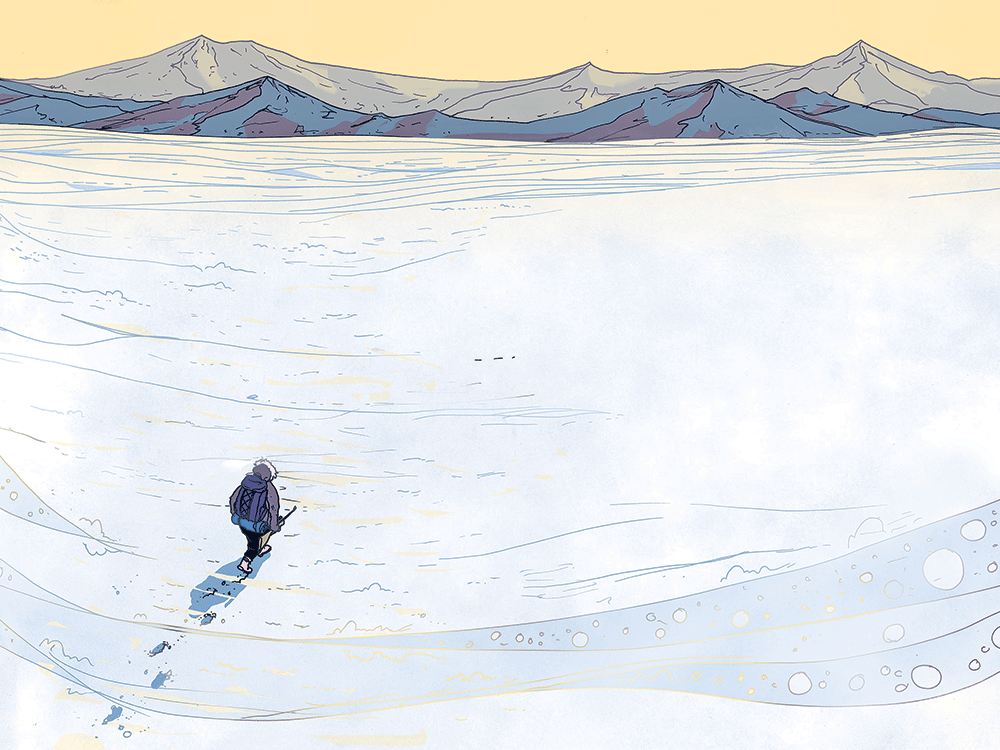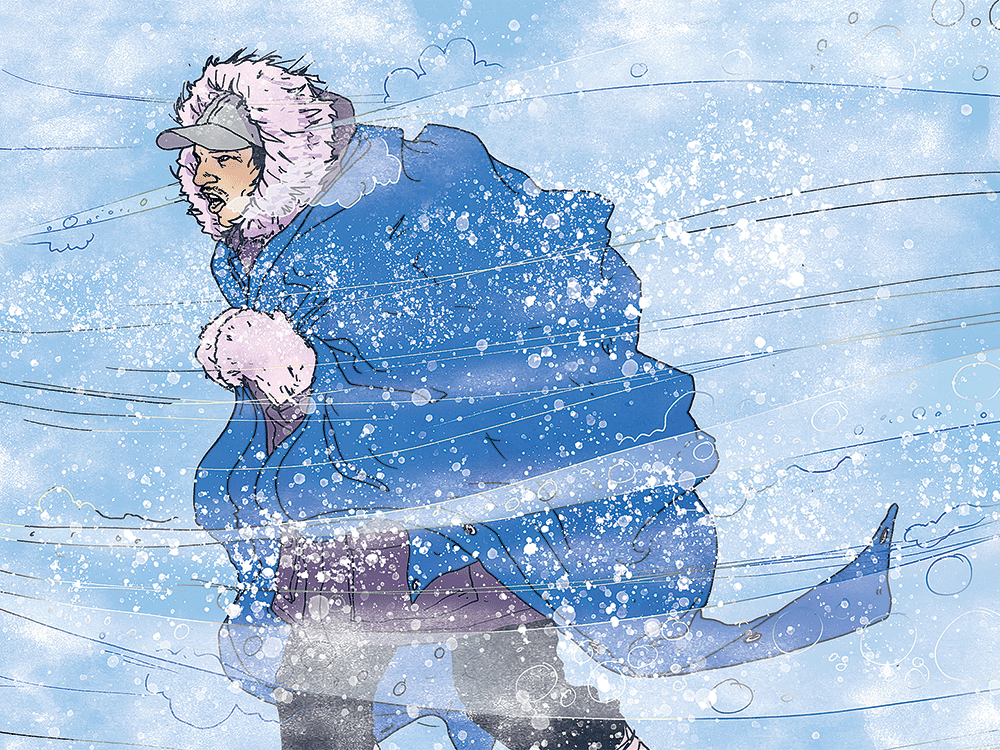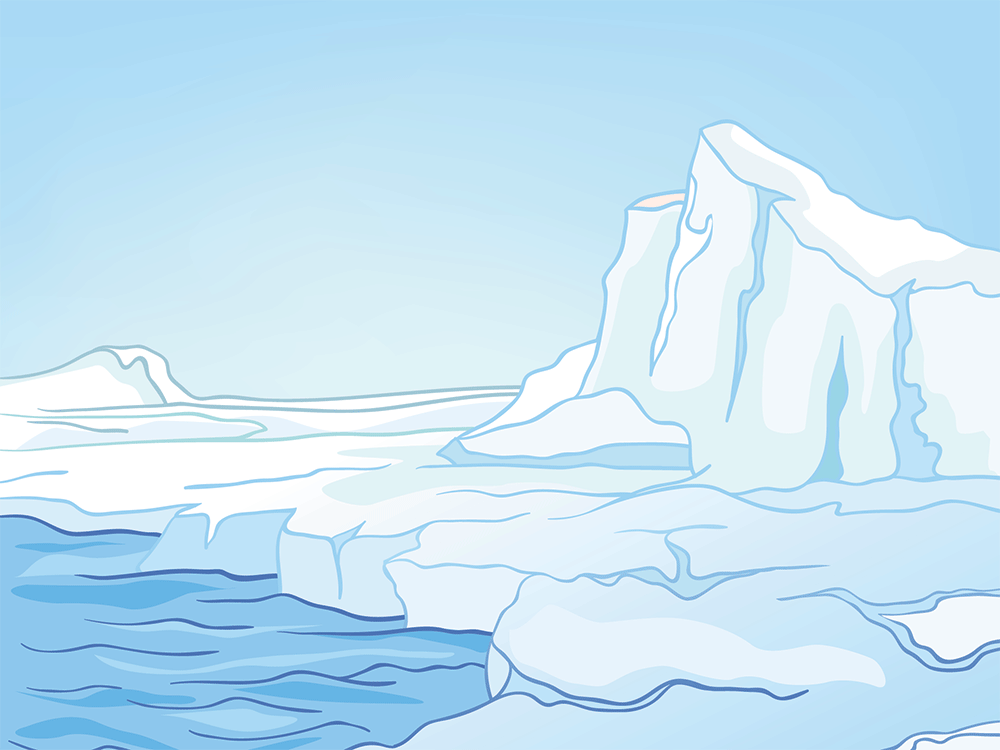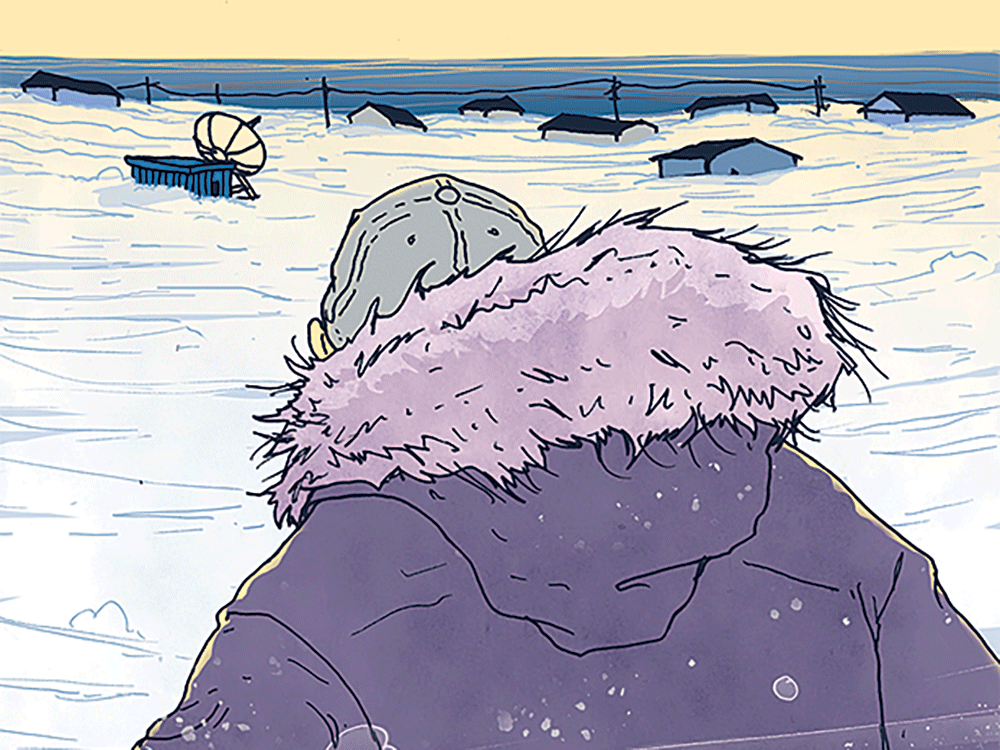
Lost in the Arctic
On Brian Koonoo’s fifth day alone in the wilderness, the snow stopped and the sun warmed the Arctic air. Koonoo ventured out of his canvas tent, huddling into his parka and adjusting his sealskin pants. He looked out at the snowdrifts, which stretched toward the horizon in every direction.
It was May 17, 2015, and Koonoo, then 36, had been out of communication range since the 13th. People were surely searching for him, he reasoned, but what were the chances they could find him and his broken snowmobile, alone in a bleak, snowy expanse just above the Arctic Circle? Koonoo climbed the hill next to his makeshift camp and scanned the dial on his hand-held radio, hoping to catch a signal. He built a fire, using what garbage he had and a little cooking oil, but it burned hot and clean, producing a smokeless flame. He looked back at the way he’d come. Snow had covered his snowmobile tracks. Any search plane looking for the stranded Inuit hunter would have a hard time spotting him—a blob of colour in an infinity of white.
For the first time, Koonoo felt an overwhelming sense of despair. He thought of his wife and five daughters, who would be worrying about him back home in Pond Inlet, Nunavut. He began to cry. In the distance, a wolf howled and Koonoo howled back. Then he made his decision: if he was ever going to see his family again, he would have to walk.
Want more suspenseful stories of survival? Check out Drama in Real Life: 40 Hours Lost at Sea.

A Turn of Fortune
The trip had started out as a polar expedition to hunt caribou. Pond Inlet is a hamlet of nearly 1,500 people at the northern tip of Baffin Island—a collection of corrugated metal houses out on the floe edge, where the sea ice melts into the open ocean. In recent years, the caribou hunt had been heavily restricted in the area to let the dwindling herd recuperate, but on the mainland, the animals were still plentiful. Koonoo’s plan was ambitious: he would travel almost 500 kilometres across the tundra by snowmobile, dragging a five-metre sled laden with supplies. Somewhere south of Hall Beach, 450 kilometres south of Pond Inlet, he would meet up with friends, spend a few days hunting caribou and then, if he was lucky, bring the much-needed game home to his family.
On May 10, Koonoo left his wife and daughters, travelled 20 hours southeast across snow and sea ice, took a short nap and kept going until he reached Igloolik, nearly 400 kilometres to the south, on May 12. He spent the night with his childhood pal Perry Atagootak and resumed his trek the next day, passing through Hall Beach.
As a Parks Canada employee who had been hunting since he was three, Koonoo was an experienced outdoorsman and had successfully completed many polar expeditions. After leaving Hall Beach, however, his bad luck began. The plan had been to travel to a series of cabins in the wilderness—simple structures the locals used. He would use his SSB radio, powerful enough to reach long distances, to determine exactly where his hunting companions were.
Now, as he stopped at the first cabin, he realized the sack containing that device and his sleeping bag had fallen off the sled during the bumpy ride—lost in the snow somewhere. Koonoo had no way of communicating except through a hand-held radio with a signal so weak it barely extended beyond eyeshot. He spent the night there, then decided the best option was to get to Repulse Bay, a day’s journey away.
Further south, the flat terrain turned into hills and valleys, with rocks and drifts that threatened to swallow the snowmobile. That afternoon, the vehicle died, felled by a transmission issue. Realizing he was stranded, Koonoo knew the best course of action was to stay put and wait for rescuers. He set up his tent and hunkered down, keeping the Coleman stove burning to try to stay warm without a sleeping bag.
When Koonoo set off, his wife, Samantha, didn’t know exactly when she would hear from him again. On a hunting trip in the north, communication is unreliable, and plans are quick to change. Samantha, 34, is working on a degree in early childhood education while raising the couple’s five daughters, aged three to 13. She was confident her husband could handle himself. But on Friday, May 15, Atagootak wrote a Facebook post wondering if anyone had seen his friend. It had been three days since Koonoo had spent the night in Igloolik. When Samantha read the note, her stomach dropped. “I called his mom and told her, ‘I’m worried about Brian,’” she says. Koonoo’s mother contacted his Parks Canada colleague, who notified search and rescue.
Over the next four days, while Koonoo braved the cold on his own, search-and-rescue teams assembled across the Canadian North. In this sparsely populated part of the country with its unforgiving environment, a simple mistake can mean disaster. One afternoon in November 2011, the mayor of Kimmirut, on Baffin Island, went on his own polar expedition to hunt caribou and disappeared into the wilderness. His body wasn’t discovered until the summer thaw the next year.
Three snowmobiles set off from Pond Inlet but were initially thwarted by blowing snow. Four searchers left from Hall Beach, more from Repulse Bay, all volunteers using their own snowmobiles to scour the trail for any sign of the missing hunter. That Saturday, the Joint Rescue Coordination Centre in Trenton, Ont., got involved, sending a Twin Otter and a C-130 Hercules to fly between Repulse Bay and Igloolik, searching for Koonoo.
At home, Samantha felt like she was losing her mind. Should she jump on a plane to try to find her husband? What should she tell their girls? She lay in their bed, trying not to look at the spot where Koonoo should have been. Why can’t they find him? she fretted. Did I lose my husband?
Want more suspenseful stories of survival? Check out Drama in Real Life: Failure on Flight 516.

Trek Across the Tundra
On May 17, Koonoo decided to take advantage of the momentarily clear skies to make his move. He had brought a GPS system, but it needed to be plugged into the snowmobile. With a jerry-rigged connection to his radio, the unit flashed to life. He was 60 kilometres from Repulse Bay, the closest hamlet. It would be a tough walk over hilly terrain in the snow, but he had no other choice.
Koonoo boiled water and filled his Thermos. He gathered the stove and tent into his tarp, but soon realized that dragging the weighty bundle would be impossible. Koonoo made the decision to fill his knapsack with essentials: his remaining ham and bread, emergency candles, plastic bags, a hunting knife, radio, GPS and ammunition. He wrapped the knapsack in the tarp and cinched it tight with a rope. He checked his coordinates and fixed his eye on the horizon. Then he slung his rifle over his shoulder and started walking.
Koonoo maintained a steady pace, tracking the wind direction and keeping the dunes aligned so as not to veer off course. He moved methodically through the snow, which was more than half a metre deep, trying not to sweat too much or become too exhausted, taking sips of hot water from his Thermos as he travelled.
In mid-May, the sun doesn’t set above the Arctic Circle. Warmer weather would soon melt the snow, but for now, temperatures remained below freezing and felt much colder when the wind picked up. Koonoo walked through the afternoon and well into the night, making his way about 25 kilometres until he couldn’t walk anymore. On the bank of a creek bed, he found a snowdrift against a rock. With his knife, he carved out a snow cave—an emergency shelter his father had taught him to build. He sliced out enough room for his body and covered the hole with his tarp. He crawled in, ate and fell asleep.
When he woke up a few hours later, Koonoo felt energized and ready to walk. But the next stretch was harder, the terrain hillier. He began playing the mind games you indulge in when you’re on your own and desperate. Keep climbing, he would tell himself, and you’ll see a hunting cabin just over the ridge. Then he’d make it to the top only to see another hill.
Midway through that day, Koonoo spotted planes in the far distance. At first he assumed they were heading to one of the small communities to the north. When they came back, he realized they were looking for him. Koonoo waved his gun in the air, hoping they’d notice the glint of the metal. As they approached, he turned on the radio, fruitlessly trying to catch their frequency as they winged past.
That night, snow was scarcer, barely deep enough to build a shelter. Koonoo cut a few blocks of snow from a drift and stacked them, then stretched his tarp between a rock and the improvised wall. He lit an emergency candle and filled his Thermos cup with snow, holding it above the flame until he could drink. Shivering, he pulled his arms inside his parka, buried his face in the lining and fell asleep.
The next morning, Koonoo was still shivering—his breath had created condensation inside his parka during the night. It was an ugly day, with blowing snow that reduced visibility to a few metres around him, and 60-kilometre winds that cut through his damp parka like a blade. For the first time, he began to panic. His core body temperature was falling, and hypothermia was setting in. He knew that if he didn’t move quickly, he would die.
Koonoo hurriedly tossed his supplies into his knapsack. As he pulled the zipper shut, it broke, so he abandoned the bag. He stuffed his knife, GPS and radio into his pockets, filled a zip-lock bag with snow and stuffed it into his parka to melt for drinking water. Then he grabbed his rifle, wrapped the tarp around his shoulders and started walking again.
Three days into his voyage on foot, with little food, sleep or water, Koonoo was suffering. He would walk 50 metres before collapsing into the snow, lying still until he summoned the energy to trudge forward again. At one point, the wind caught the tarp, ripping it from his hands. He chased after the scrap of plastic, but it was out of reach. Weak and exhausted, he watched it sail away. With little water, he was becoming dangerously dehydrated. One leg cramped, and Koonoo silently prayed for strength, limping along until he regained mobility. Then the other leg cramped.
Weary, he collapsed once again. This time he didn’t rise. This is how it feels to give up, he thought, gazing at the snow swirling across the sky. His legs were at rest. He let his mind drift.
Want more suspenseful stories of survival? Check out Drama in Real Life: A Fiery Rescue.

Home at Long Last
Lying there, Koonoo dreamt of his family. At home in Pond Inlet, their life was simple—watching movies at home, hunting seal on the ice. In his mind, he heard his youngest daughter, Alina, a rambunctious preschooler who seemed to be constantly laughing, impossibly happy. “Ataata,” she said, Inuktitut for father. Suddenly, he was jarred awake. A nearby ptarmigan kept calling, an irritating cluck that seemed to grow louder and louder. Koonoo sat up. Okay, I’ll start walking, he thought as he rose to his feet. I want to see my wife. I want to see my kids. I want to see them grow up.
Koonoo trudged on. At times the hills were so steep he needed to use his knife to cut footholds into them. About eight kilometres from Repulse Bay, he spotted radio towers—the first sign of a community. He staggered forward until he glimpsed a cabin at the top of the hill. With the last of his energy, he climbed up and broke in.
Inside, Koonoo turned on a Coleman stove and immediately heated some snow, gulping down the warm water. He found a package of vegetable soup mix and ate that. He removed his boots for the first time in a week and saw his feet—pale as snow, curled and wrinkled. Then he found a blanket, hunkered down on the couch and slept for 12 hours.
The walk into town the next day, May 20, was easy, and Koonoo arrived at 5:30 a.m. to find everyone asleep. He suddenly felt shy. Koonoo didn’t know anyone in Repulse Bay, and he surely looked like a crazy person.
Koonoo saw a taxi pull out from a house and figured its inhabitants would be awake. He approached the home, removed his rifle and knife and opened the door.
A woman was dozing on the couch. Koonoo knocked on the wall and awkwardly began to explain who he was, what he had been through. He didn’t get far before he broke down. The woman stared at him. “You’re the guy we were looking for,” she said. The woman’s husband had been part of the search-and-rescue operation, trying to find the man who had just stumbled through her door.
Today, safe at his home, Koonoo gets emotional when he recounts the welcome he received. “Everyone was very happy everywhere I went,” he says. He recalls how the woman and her husband made him hot drinks, the feast in the school gym, the way the hamlet’s elders came to meet him—the man who had survived in the wild, the man who had refused to give up.
Back in Pond Inlet, he had another homecoming. At the edge of town, where the sea ice meets the shore, his community came out to welcome him. When Koonoo held his wife and kids in his arms, he broke down again. He cried—everyone did—and then the throng clapped and cheered as he took his last steps home.
Want more suspenseful stories of survival? Check out Drama in Real Life: Airplane on Fire!